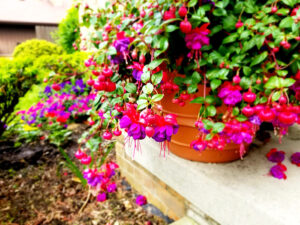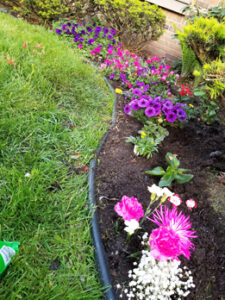
By Carla Janell Pattin, PhD
Guest Column
While I did not grow up gardening for fruits and vegetables, I have fond memories of my mother planting beautiful flowers, appearing as a rainbow in the distance. She worked for hours on her lawn as if each task was a form of prayer.
Our next-door neighbor, James Carlisle, grew a large garden and delivered fresh produce throughout the neighborhood. I understood the same feeling of toiling over my soil and spirit and my part of the Earth as a place of peace, discovery, and community.
I started gardening in 2015 in need of a place to escape from my doctoral studies. I soon began to enjoy seeing the growth of tomatoes and cucumbers for the first time. Once I grew in knowledge, I established gardens for others and got educated on food access in my community. As I tossed around the soil with more experienced Black gardeners, I absorbed their stories of beauty, struggle, and survival in the natural environment.
Black people have grown through many circumstances, which compels me to share our knowledge about gardening in such a time as this, hoping to increase the faith of others to grow a garden or get involved in their local community garden.
My name is Carla Janell Pattin, I am an assistant professor of Humanities at The University of Toledo’s Honors College, and I am a gardener. Throughout the season, I am working at Grace Community Center (GCC) in Toledo, serving on the farm and bearing witness to Central State University’s Fast Track Farming Program, delivering culturally relevant farming education to the community.
 Throughout the growing and harvest seasons, I will share the process of growing food, especially for those who believe they do not have a “green thumb. First and foremost, a “green thumb” is a person who handles many pots stained with algae and has green fingers as a result.
Throughout the growing and harvest seasons, I will share the process of growing food, especially for those who believe they do not have a “green thumb. First and foremost, a “green thumb” is a person who handles many pots stained with algae and has green fingers as a result.
The knowledge of growing your own food is your birthright. If you are too nervous to try it yourself, come to GCC’s urban farm and enroll in CSU’s Fast Track Farming Program or get involved in your local community garden. Many outstanding farmers and gardeners in Toledo will help get you started. In the meantime, I would like to share the basics of growing food.
What is a Garden?
A garden is a collection of fruits, vegetables, flowers, and herbs growing in your yard or balcony to prepare your family’s meals. A garden is your personal ecosystem, which is a collection of plants, animals, climate, weather, bugs, soil, and other features that make your garden grow. Your garden can be of many sizes, ranging from one pot on a balcony to a large homestead.
 Location
Location
Your garden should be close to a water source. There is no fun in dragging a heavy water hose across the yard, especially in 90-degree weather. Installing a drip irrigation system is best for the growth of plants because overhead sprinkling systems can damage your plants. Your garden should be away from puddles and soggy soil because there is insufficient drainage.
Pick a sunny spot and remember that trees, fences, and your house cast shadows, making it hard to grow crops that need a lot of sun. Finally, think about the amount of time you want to spend in your garden. It takes about two minutes per square foot to maintain a garden per week. If you have a 2×3 garden, you’ll spend about 12 minutes per week on upkeep. Growing pots of mint, lavender, basil, and fresh thyme will do just fine! Growing herbs is the easiest, next to the collard green family members like cabbage and kale. Did I convince you already?
What is Soil?
Topsoil is the top layer of the Earth, comprising a mixture of organic material. Soil can make or break your garden, so conducting a soil test for possible contaminants is critical. A soil test may not be necessary if you build a new raised bed and purchase soil for the first time. However, it is important to know the history of the space, including the Native American communities that once thrived in your part of Northwest Ohio!
If you have a garden in the previous years, crop rotation is necessary, changing the plant family in your garden. Let’s say you planted peas or beans this year. In year two, you should plant beets, carrots, and onions. You can plant eggplants, tomatoes and cucumbers in the third year. You can grow lettuce, collards, and cabbage in the fourth year. Planting the same plant family in the same space year after year will breed diseases, and most people give up after this. It would be best to write down everything you’ve grown in prior years. I hope I didn’t lose you! Please keep reading, and I promise it gets better.
Plants Love Fluffy Soil
If you have not started your garden, turn the soil over to fluff it out. Soil needs air pockets for roots to breathe. That is why you should never walk on the soil. Walking on soil collapses the air pockets and packs the soil together, making it challenging for plant roots to breathe, stretch, and grow. Remember to wear gardening gloves and always wash your hands before and after touching the soil. Soil is the giver of life, but it also carries pathogens that can be dangerous to you and other plants.
Secret Soil Blend
I am dishing my secret soil blend to the Toledo community. Are you ready? My custom soil blend includes worm castings, potting soil, compost, and a little bit of sand (not play sand). Worm castings is a beneficial fertilizer that can help the plants produce giant vegetables. Potting soil is a mix of peat moss, perlite, and vermiculite, all the good ingredients for plants. The small amount of sand (n
ot play sand!) is good for drainage and texture. Compost is decomposed plant matter, including rotten plants, grass clippings, sticks, and more. Then, I mix these components, water the soil, and plant my crop. So there you have it—my secret to a thriving garden. GCC has a unique soil blend for the farm that can rival any large-scale operation. You’ll have to stop and speak with Preston Ingram, GCC’s farm manager, for their secret!
Get the Bags
Knowing the correct number of bags of soil prevents frequent trips to the nursery. I calculate the length multiplied by the width of the garden. You must include the depth in the calculations if you are growing a garden in a raised bed. For example, if a raised bed is two feet wide by three feet long and one foot in depth, the calculation is 2x3x1=6 cubic feet, which equals about six to seven bags of one cubic foot bag of soil. Got it?
Plant Food
Gardening is a billion-dollar industry, and companies are good with labeling products to increase consumer spending. Have you seen products labeled as plant food? The reality is plants are the only living organism that makes their own food. Plants get their food from sunlight, carbon dioxide, and water. The plant uses these elements to make sugar, and the plant releases oxygen. Products labeled as plant food are merely vitamins and minerals so that the photosynthesis process can run smoothly (and so much more). Always read the directions before treating your crops.
Level Up
A raised garden bed, also known as a grow box, is a structure that allows you to grow a garden elevated from the ground. Raised beds clearly define your garden against the yard space. Raised beds encourage the plant’s root system to grow vertically. In addition, they keep the soil warm over the winter, allowing you to start planting cold crops like spinach in early spring. GCC farm is entirely grown in raised beds, and the amount of harvests from their raised beds is commendable. I would encourage you to check us out!
Vertical Gardens
I am a huge fan of vertical gardens. To grow up, you can use stackable pots, lattices, cow panels, garden arches, obelisks, and more. Plants like Kentucky Wonder green beans, cucumbers, and some varieties of tomatoes will climb trellises, and it is incredible to witness. Vertical gardening encourages upward growth leaving more room to grow other plants. They are perfect for people who have chronic pain or those who have trouble bending their arms and legs.

Lastly, vertical gardens allow huge growth. Cucumbers and melons can grow up to eight feet or more, while beans and tomatoes can grow fifteen feet. Some varieties of grapes can grow up to a whopping length of fifty feet! Make sure the structure is strong enough to withstand the weight of these massive plants and hanging harvests. I have had structures collapse due to the heaviness of these plants.
Gardening Benefits
In addition to growing healthy foods, gardening provides privacy and a chance to escape the inequality and stress-inducing microaggressions we often experience. For many of us who are challenged by carceral logistics, a garden offers a quiet, personal space to reflect, wonder, and dream about the future. Growing a garden regulates blood pressure, reduces stress, and can provide a good workout. A garden can heal you from hurtful events, and it can relieve feelings such as anger, fear, and anxiety.
I’ve listened to the stories of Black gardeners over the past few weeks, and they have all concluded that having a garden teaches creativity and the value of a dollar. Their wisdom reminds me of Ron Finley’s 2013 TED Talk when he famously declared, “Growing your own food is like printing your own money.” Gardens can save you trips to the local grocery store because you’ll grow your family’s priority dishes.
My family loves kale, we grow about 10 kale plants each year, and we rarely purchase it from the store. Instead, we cook innovative dishes with our excessive amount of kale, tapping into the meaning of soul food and remixing our foodways. This creativity brings families a sense of joy. The process of reaping what is sown leads to the great pleasure of a harvest.

Let’s Get Growing
I am happy to share gardening basics to increase your faith in the power of the soil and the blessings that come from it: free food and so much more. I will share more tips, tricks, and pitfalls I’ve learned throughout the planting and growing seasons.
If you are interested in learning more about gardening, please follow me on Instagram @Theharvestdoctor or contact me via email Carla.pattin@utoledo.edu. For hands-on training in urban farming and education on how to bring your garden to scale, contact Grace Community Center’s farming manager, Preston Ingram, at 419-248-2467 to enroll in the Central State University’s Fast Track Farming Program.
